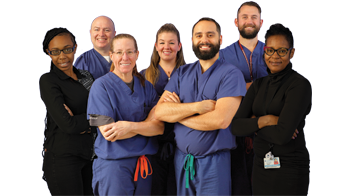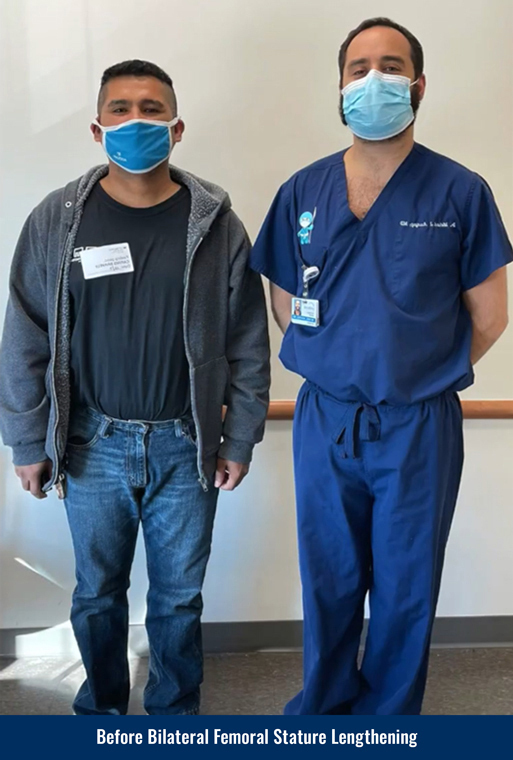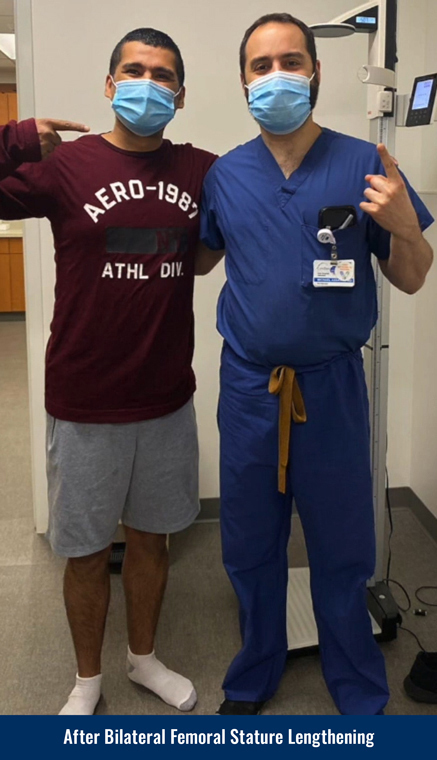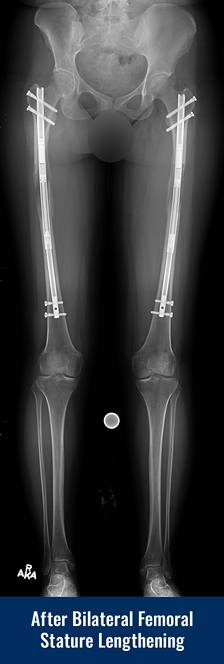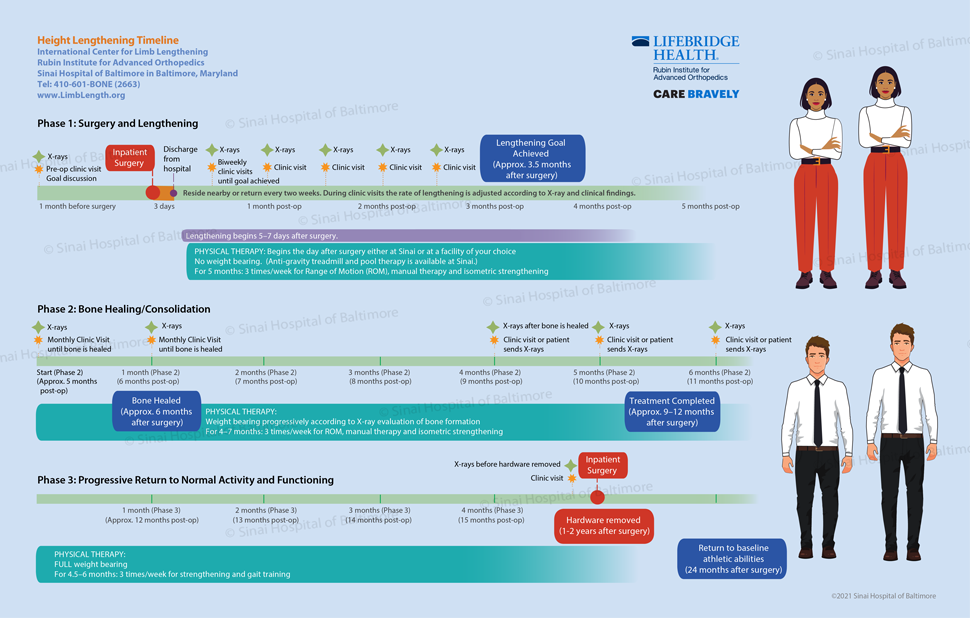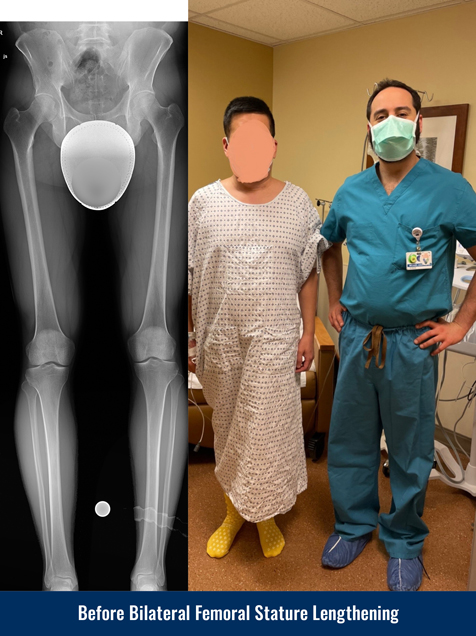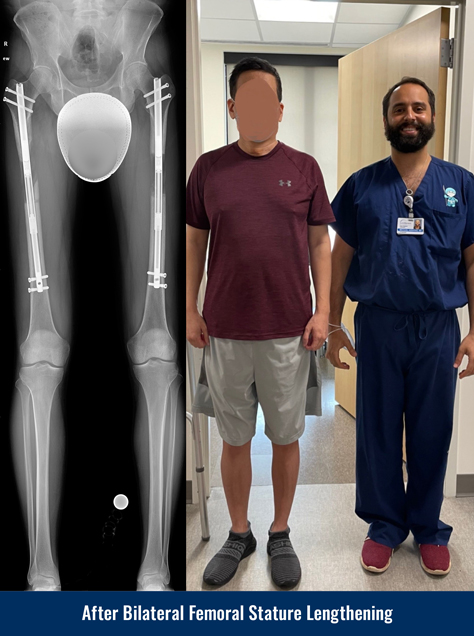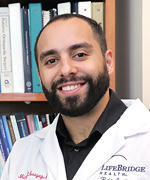Short Stature: Want to Be Taller? (Cosmetic Height Surgery)
The International Center for Limb Lengthening performs cosmetic height surgery, also called stature lengthening, for healthy individuals who are unhappy with their height and want to be taller. [Note: If you are considering limb lengthening due to a dwarfism condition, please see this page.] For those interested in height enhancement, we offer bilateral simultaneous leg elongation—where both legs are lengthened at the same time using Precice (NuVasive) internal nail technology.
Who is a candidate for cosmetic height surgery?
Candidates for cosmetic stature lengthening must be fully informed, highly motivated and financially able. To be considered, you must be a healthy non-smoker who has reached complete skeletal maturity. All candidates should be psychologically stable and have the support of their family. We do not set specific initial height requirements, because we assess individuals on a case-by-case basis.
How much taller can I get?
The total recommended lengthening is 2-3 inches (5-8 cm) in the thigh bone (femur). Lengthening more than 3 inches in one bone is associated with higher complication rates, and our doctors put patient safety first. If desired, another entirely separate lengthening procedure can be performed one year later in the shin bones (tibiae) to gain up to an additional 2-3 inches (5-8 cm) of height.
How much does cosmetic height surgery cost?
Cosmetic surgeries are not covered by medical insurance. Click here to visit the HeightRx website for cost estimates for femur lengthening and tibia lengthening.
Is elective stature lengthening covered by medical insurance?
The initial consultation, hospitalization, surgery, physiotherapy and follow-up care are not covered by insurance. Please note that while unlikely, should complications arise that require additional surgery or treatment, the patient would also be responsible for those expenses.
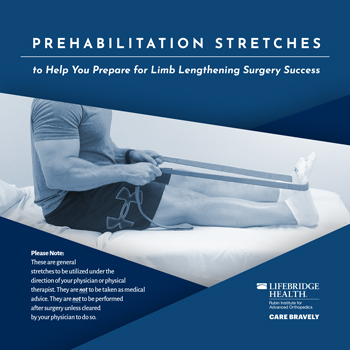 To help you prepare for limb lengthening surgery success, we have developed this brochure of prehabilitation stretches to perform in the months prior to surgery. This is not medical advice; please consult with your doctor before beginning any exercise regime.
To help you prepare for limb lengthening surgery success, we have developed this brochure of prehabilitation stretches to perform in the months prior to surgery. This is not medical advice; please consult with your doctor before beginning any exercise regime.What happens during the initial consultation?
The first step is to make an appointment for a thorough evaluation. At this visit, the doctor will examine you and have a frank and detailed discussion about stature lengthening. Proper X-rays will be taken to enable our doctors to plan carefully for the procedure.
How do I schedule the surgery?
After your initial evaluation with our doctors, if you are a candidate for cosmetic height surgery, you will be given information to schedule the surgical appointment at your convenience.
Which bones will be lengthened?
For an overview of the limb lengthening process, click here. We recommend simultaneous lengthening of both femur (thigh) bones. Two femoral Precice internal devices are inserted during one surgery. The tibia (shin) bones can also be lengthened as a separate procedure a year after femoral lengthening.
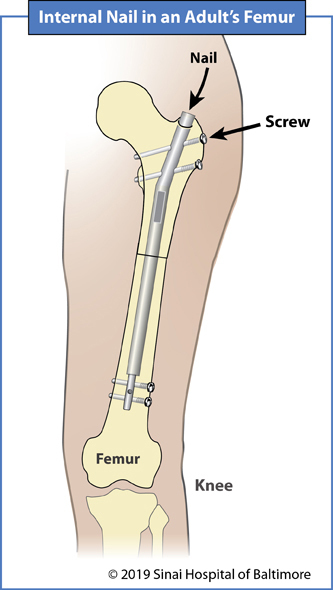
How do you lengthen the bones and soft tissues?
The bone is cut through a 1-cm (<0.5-inch) incision. The Precice telescopic internal lengthening nail is inserted into the marrow of the bone and is fixed to the upper and lower part of the bone with screws. Unlike previous devices, such as the ISKD, the Precice nail is accurate and controllable. The Precice nail can even be programmed to go in reverse to compress the bone, if needed, to help speed healing. Some of our surgeons at the International Center for Limb Lengthening were on the original surgeon design team of the Precice device. We have implanted over 600 Precice nails as of October 2021, making us one of the most experienced institutions in the world performing limb lengthening with Precice internal magnetic lengthening nail technology.
Additional procedures may also be performed to prevent nerve problems and to help the patient gain full range of motion during physical therapy. These procedures include peroneal nerve decompression, injection of Botox into the thigh muscles and fascia lata (deep connective tissue in the thigh) release. The need for adjunct procedures will be evaluated on a case-by-case basis.
Five to seven days after surgery, you will begin the lengthening process. The Precice nails are telescopic rods that contain a miniature magnetic motor. The magnetic motor is activated by applying a magnetic field generator to your thigh, called an External Remote Controller (ERC). When the motor is activated, the telescopic rod lengthens, which lengthens the bone and soft tissues. The magnetic field generator is applied two to four times per day, as recommended by your surgeon, to lengthen a total amount of up to 1 mm per day. Most people do not experience any pain when the magnetic field generator is applied.
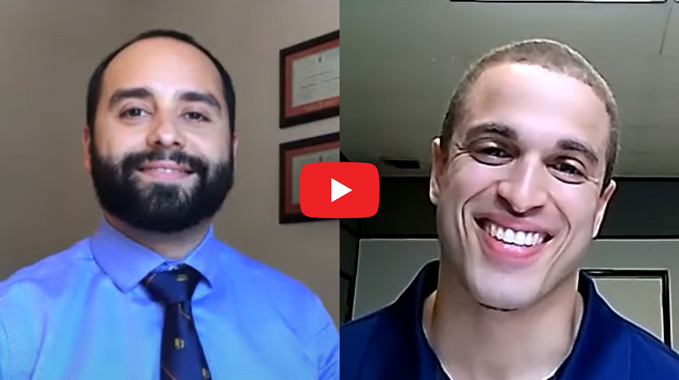 Dr. Michael Assayag discusses cosmetic height surgery in this interview with Victor Egonu — Cyborg 4 Life.
Dr. Michael Assayag discusses cosmetic height surgery in this interview with Victor Egonu — Cyborg 4 Life.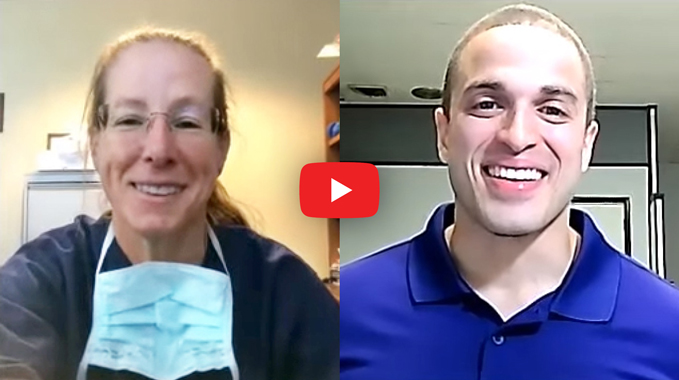 Dr. Janet Conway discusses cosmetic height surgery in this interview with Victor Egonu — Cyborg 4 Life.
Dr. Janet Conway discusses cosmetic height surgery in this interview with Victor Egonu — Cyborg 4 Life.
What happens after the initial surgery?
Expect to be in the hospital for three days after surgery. You will start physical therapy while you are in the hospital and continue physical therapy throughout the entire lengthening process. Physical therapy is critical to a successful lengthening, and the Rubin Institute’s physical therapy program for limb lengthening patients, led by Anil Bhave, PT, is the most experienced in the United States, if not the world.
While in the hospital, you will be trained how to use the ERC to lengthen the Precice internal rod. After training, you will bring the ERC home and use it to lengthen the rod as prescribed by your surgeon.
During the lengthening process, you will need to be seen by your surgeon in the clinic every 10-14 days for X-rays and a physical examination. Please note that you will not be able to bear weight on your legs for the first lengthening phase and will need to use a wheelchair or scooter. During the post-operative visits, X-rays are made to monitor the bone healing. Based on the X-rays, as well as joint flexibility, we may speed up or slow down the lengthening rate.
Where can I stay during the lengthening process?
Inexpensive, comfortable housing is available right on the campus of Sinai Hospital at the Hackerman-Patz House to make this easier for you. It is required that you have an adult caregiver (relative, friend, significant other) stay with you at the Hackerman-Patz House. If family or friends are not available to help, this type of service can be hired.
What happens after I complete the lengthening process?
After you complete the lengthening process, you will need to see our doctors monthly until full bone healing is achieved (typically 6-8 months). In some cases, X-ray follow up can be done remotely. In rare cases where the bone does not fully heal (nonunion), bone grafting (additional surgery) may be required. Weight bearing progression is determined by X-ray of the bone formation. Approximately one year after lengthening, you will be able to resume normal activity and function and can undergo surgery to remove the Precice nails. Removal is recommended, as the nails contain a magnet inside which would otherwise preclude you from getting an MRI scan in the future. The removal procedure is an outpatient surgery, which means that the patient does not need to stay in the hospital overnight after the removal.
What are the potential limb lengthening complications?
While there can be many potential complications with limb lengthening, most of them are not likely to occur. Our stature lengthening team is very experienced in limb lengthening and puts our patients’ safety first. Possible complications will be discussed with you in detail during your initial consultation and again during your pre-surgical visit. They include nonunion, leg length discrepancy, nerve stretch injury, muscle/tendon contracture leading to stiff joints, and joint arthritis. Medical complications can include deep vein thrombosis and fat embolism. In rare cases, the bone might fail to heal completely and bone graft surgery might be required. A nerve may become too stretched, which occasionally requires surgery to decompress the nerve. Tight muscles and tendons might require tendon-lengthening surgery. Again, these problems are unlikely in most cases, but, should they occur, they can be corrected by surgery. Lengthening that occurs too slowly or failure to place the magnetic field generator directly over the internal magnet in the Precice nail can lead to premature bone healing. If this happens, additional surgery is needed to re-cut the bone to allow the lengthening process to continue. Please note that if additional surgeries are required, they also will not be covered by insurance, so they must be paid out of pocket. Our doctors are leading experts in the field, and they closely monitor patients’ lengthening progress to help prevent complications and catch any issues that do arise early so they can be addressed as soon as possible.
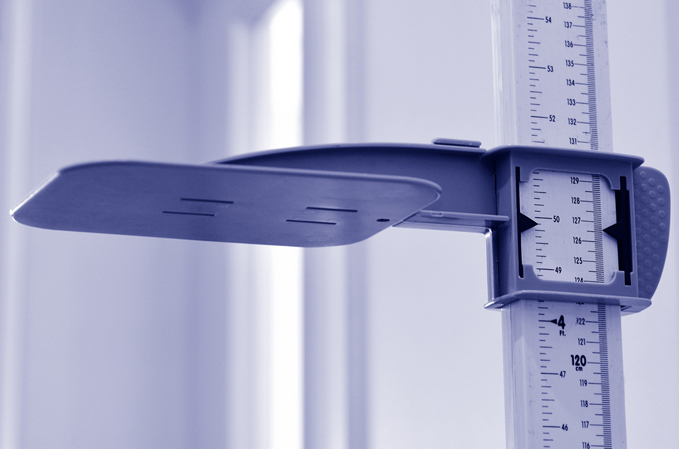
What results have we seen after limb lengthening?
The majority of our patients achieve excellent results without significant complications. Those who do experience complications usually achieve good outcomes as long as the complications are recognized and treated promptly. It is a lengthy rehabilitation process, and it can take up to one or even two years until full recovery and return to normal function is achieved, including sports activities. Our patients do not only gain height; many also report higher self-confidence and self-esteem after we help them achieve their lengthening goals.
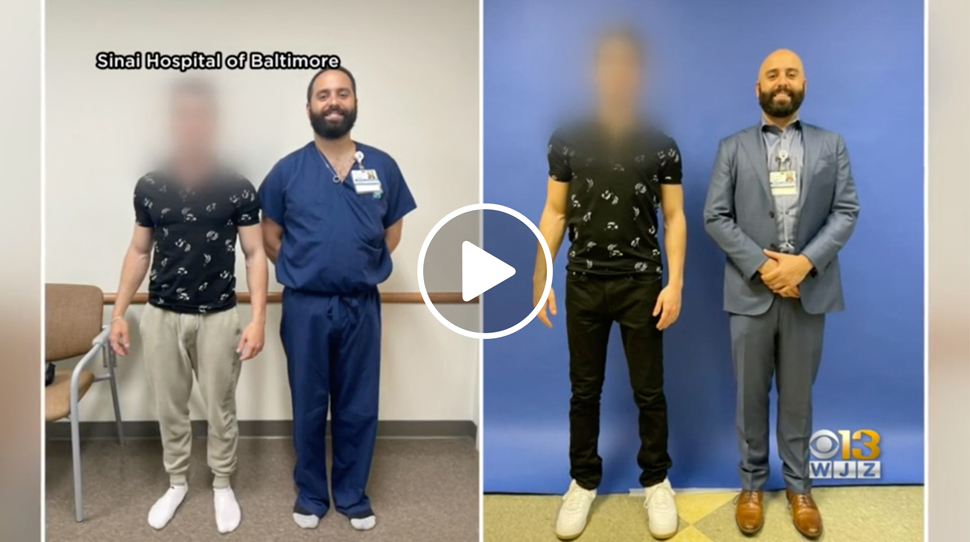 Dr. Assayag and one of his patients are interviewed in this WJZ story about cosmetic height surgery.
Dr. Assayag and one of his patients are interviewed in this WJZ story about cosmetic height surgery.Why choose the International Center for Limb Lengthening for cosmetic height surgery?
Limb lengthening should always be performed by experienced surgeons. The International Center for Limb Lengthening is one of the most experienced centers for limb lengthening in the world, and we put our patients’ safety first. Our patients have come from over 60 countries and six continents to receive comprehensive orthopedic treatment by our world-renowned team. Your doctor will take the time to make sure you understand all of your options and then will customize your treatment to meet your specific needs. Our patients benefit from our team-centered approach with expert orthopedic surgeons and specialized physician assistants, nurses and physical therapists. We help patients who undergo cosmetic height surgery achieve their best possible result.
